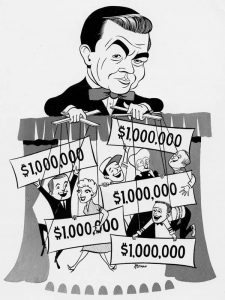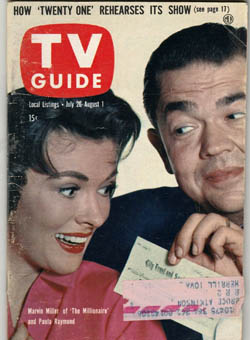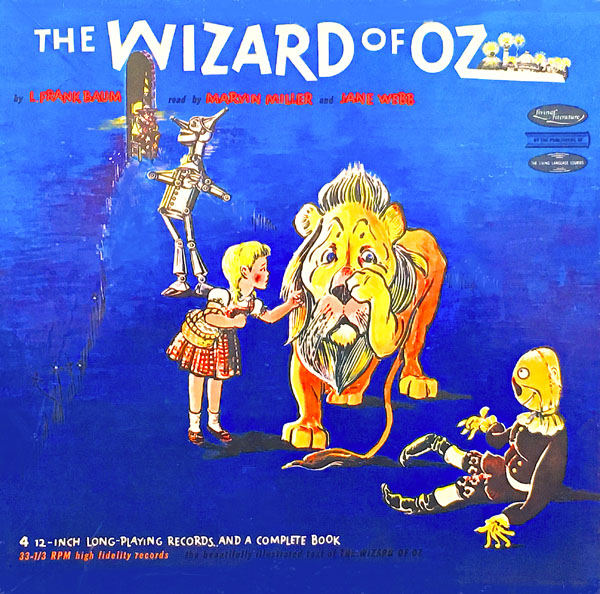 This week we offer a long-overdue appreciation of the versatile animation and live-action actor/narrator who would be 107 this Saturday, with a career spanning over half a century.
This week we offer a long-overdue appreciation of the versatile animation and live-action actor/narrator who would be 107 this Saturday, with a career spanning over half a century.
According to the groundbreaking book, Radio’s Golden Age: The Programs and the Personalities by Frank Buxton and Bill Owen, no other performer has more classic radio credits that Marvin Miller. Indeed, when before he left Chicago’s center of radio drama and comedy for Hollywood, he was either announcing or acting on a minimum of 45 programs per week. From his native St. Louis to Chicago to Los Angeles, just a few of the shows included The Railroad Hour, The Firstnighter Program, The Whistler, The Romance of Helen Trent, Tell Me a Story, One Man’s Family, The Andrews Sisters Show and Ma Perkins.
“When I got up to Chicago, they simply said, ‘Well what are you? Are you an actor or are you an announcer? You can’t be both,’” Miller recalled in a 1973 radio interview with radio historian Chuck Schaden. “But the only way I actually got around it in Chicago was to tell the advertising agency people that I was an announcer, and tell the directors that I was an actor—and sometimes I met myself coming and going. I’d be announcing a show and suddenly get a part on it!”
 Classic radio buffs know Marvin Miller for his vast career in the golden days of radio, though he continued to act and announce on programs throughout the seventies. For television viewers, he was a household name when The Millionaire (1955-1960) was a hit CBS series. Miller played Michael Anthony, executive secretary to billionaire John Beresford Tipton (played by another voice acting legend, Paul Frees, unseen behind a big important puffy chair).
Classic radio buffs know Marvin Miller for his vast career in the golden days of radio, though he continued to act and announce on programs throughout the seventies. For television viewers, he was a household name when The Millionaire (1955-1960) was a hit CBS series. Miller played Michael Anthony, executive secretary to billionaire John Beresford Tipton (played by another voice acting legend, Paul Frees, unseen behind a big important puffy chair).
Each week Anthony was given a check for (gasp!) a million dollars for some random person Tipton somehow selected. Each week featured a different result—happy, sad, funny or heartwarming—and guest stars like this episode with Betty White . “One of the reasons it was such a popular show is that everybody dreams that,” Miller told Schaden. “The whole idea of the series was what happens to people when a fortune falls into their laps, and how does it affect their lives. It was a good idea and it certainly caught on and held because it ran six years in prime time.”
Marvin Miller was so visible on camera as an actor or recognizable as an announcer once you got to know his voice (on ABC’s long-running The FBI, for instance), that his significant contributions to animation history are most often overlooked. One of the most renowned animated features begins with his voice. Though uncredited, it rarely comes up while other details do.
Another of his Disney credits is this whimsical slice of pie in the sky:
While most kids of Miller’s day had no idea what The Millionaire TV show was, they might have heard his voice on RCA or MGM’s Dr. Seuss records, and most definitely were familiar with the bumpers between cartoons on various Pink Panther shows that ran on NBC:
One of the times he played an animated lead was in Filmation’s Aquaman series (opposite Jerry Dexter), though he supplied many incidental characters for such shows as Jonny Quest, Fantastic Four, Lone Ranger, New Adventures of Huckleberry Finn, Fantastic Voyage, Here Comes the Grump and the feature Fantastic Planet.
If you were of school age in the mid- to late-20th century, and lucky enough to have your school day interrupted by a 16mm movie and even luckier that the movie had good animation in it, chances are it was either a Disney or a Bell Science film.
Originally made for CBS TV and produced by movie legend Frank Capra, the Bell films were ambitious and went way over budget because of their animation and their efforts to make things as entertaining as possible. They might still seem a little stodgy to today’s kids, but compared to Coronet or Encyclopedia Britannica Films back then, they might as well have been Marvel Avengers films.
Miller voices the title role in the first two, which both won Emmy Awards. Eddie Albert and Sterling Holloway are on camera for 1956’s Our Mr. Sun, and Lionel Barrymore—who Capra cast in It’s a Wonderful Life—voices Father Time (not Allen Swift!). The animation studio was none other than UPA.
Some consider Hemo the Magnificent among the series’ best. In addition to Miller, the voices include June Foray and Mel Blanc. This time, Shamus Culhane’s studio did the animation. Sterling Holloway returns and sci-fi stalwart replaces Albert. The constant in all these films is “Dr. Research,” Frank Baxter, who was a very expressive and popular USC professor of English, not of science. He has a star on Hollywood Blvd. There is a fascinating book about the entire series called Sonnets to Sunspots: Dr. Research Baxter and the Bell Science Films by Eric Niderost.
Of all animation studios, the aforementioned UPA may have benefitted most from Marvin Miller’s voice acting and narration skills. His association began with their very first film. Under the name “Industrial Films,” the studio that was to become United Productions of America became prominent after making this powerful 1944 campaign film for Franklin D. Roosevelt, directed by Chuck Jones.
Like a razor-sharp newspaper political cartoon come to life, Hell-Bent for Election is filled with the offbeat styling and daring approaches that were unheard of in 1944, though the animation is much fuller than what UPA would eventually develop. Miller is credited in several accounts as “narrator,” but the film doesn’t have one. He is, rather, the voice in “Joe’s” nightmare.
When UPA was up, running and collecting awards and praise, Miller’s voice was in many of the films, including the entire Gerald McBoing-Boing series: Gerald McBoing-Boing’s Symphony, How Now Boing-Boing, Gerald McBoing! Boing! On the Planet Moo, and the original film:
He wasn’t always the narrator. In this film, he plays everyone—the title role, his father, Bilgewater and T.J. Tailgate:
And here he is as both George and Irene Fudget:
In the case of Mister Magoo, he was both narrator and actor. He narrates this film made for the American Cancer Society:
And he narrated most of The Famous Adventures of Mr. Magoo as well as playing numerous roles. (Robie Lester fans note that she appears in this Don Quixote segment):
It would be remiss to not also mention his role as the voice of Robby the Robot in Forbidden Planet; the Zarn on Land of the Lost; and the narrator of Electra Woman and Dyna Girl.
Miller served on all three entertainment academy boards: movies, TV and recordings (he served on the recording board alongside June Foray, who he said was there because of her children’s recording expertise).

THE WIZARD OF OZ
by L. Frank Baum
Performed by Marvin Miller and Jane Webb
Living Literature Records (Crown Publishers, New York) LIT-C (Four 12” 33 1/3 LP Box Set with Book / Mono)
Originally Released on 16 1/3 rpm Discs by The Audio Book Company, St. Joseph, Michigan.
Released in 1961. Running Time: 3 hours, 35 minutes.
Voices: Marvin Miller (Narrator, Uncle Henry, Munchkins, Bok, Scarecrow; Tin Woodman; Cowardly Lion; Field Mice, Man with Injured Leg, Guardian of the Gates; Oz Courtier, Oz as a Head; Oz as a Beast, Oz as a Ball of Fire, Flying Monkey King, Winkies, Invisible Oz, The Wizard, China Clown, Tiger, Hammerhead); Jane Webb (Aunt Em, Dorothy, Witch of the North, Stork, Queen of the Field Mice, Farm Woman, Green Girl, Oz as a Lady, Wicked Witch of the West, China Milkmaid, China Princess, Quadling Farm Woman, Soldier, Glinda).
While this production of The Wizard of Oz was not animated per se, it is imbued with animated voices. Between Marvin Miller and Jane Webb, you have decades of TV and movie cartoon voices in one form or another taking form within L. Frank Baum’s classic journey. (You can read more about Miller’s Dr. Seuss records in this Spin).
 In his 1973 interview, Marvin Miller told Chuck Schaden, “The name of the company is Audio Book, and this was an outgrowth of the VM Record Changer people who put that fourth speed on record players which most of them still have—16 2/3 rpm. Unless the record is really hi-fi, it will “wow” if it’s musical on that slow speed, but voices don’t, so it’s a heckuva good way to get literature in a small amount of shellac or plastic.
In his 1973 interview, Marvin Miller told Chuck Schaden, “The name of the company is Audio Book, and this was an outgrowth of the VM Record Changer people who put that fourth speed on record players which most of them still have—16 2/3 rpm. Unless the record is really hi-fi, it will “wow” if it’s musical on that slow speed, but voices don’t, so it’s a heckuva good way to get literature in a small amount of shellac or plastic.
“I think they were great fun. I recorded three for kids—unedited. That is complete, not just cut down versions—Alice in Wonderland, The Wizard of Oz and Pinocchio. I did the Alice in Wonderland and The Wizard of Oz with a very delightful actress, Jane Webb, who’s also from Chicago and who does a lot of commercials… she’s the voice of practically all of the characters on The Archies, on the cartoon show on Saturday mornings.
“She did all the female roles, I did all the male and the straight storytelling, but on Pinocchio, I did the whole thing and there were fifty voices and that was quite a jar. I also did The Meditations of Marcus Aurelius, a book of Poe, a book of Mark Twain, and an anthology of essays that goes from Chaucer to Alfred Noyes.
“The one that was the most challenging of my entire career, and the one that I’m really proudest of doing, and that was I recorded the entire bible. It took me two and a half years. The New Testament alone takes almost 24 hours to play; the Old Testament takes four days and four nights.”
The “Audio Book Company” had previously reissued Miller and Webb’s The Wizard of Oz and several other recorded books on cassette, followed by a smaller selection on CD. However, there does not seem to be a sign of the company nor its products at this time. The company website has not been updated since 2010 and the toll-free number on the site does connect to their company. Therefore The Wizard of Oz is presented here for historic research and educational purposes. These recordings should be preserved and enjoyed for all time.


 GREG EHRBAR is a freelance writer/producer for television, advertising, books, theme parks and stage. Greg has worked on content for such studios as Disney, Warner and Universal, with some of Hollywood’s biggest stars. His numerous books include Mouse Tracks: The Story of Walt Disney Records (with Tim Hollis). Visit
GREG EHRBAR is a freelance writer/producer for television, advertising, books, theme parks and stage. Greg has worked on content for such studios as Disney, Warner and Universal, with some of Hollywood’s biggest stars. His numerous books include Mouse Tracks: The Story of Walt Disney Records (with Tim Hollis). Visit 






















































Miller and UPA also combined for the voice over and opening animation to The Danny Thomas Show during the CBS portion of it’s 11-year run, with Miller pitching Maxwell House Coffee, Post Cereals and other products from General Foods. The version that’s available from various locations on YouTube apparently was animated in 1958 — here’s the opening with Miller from what ended up being the pilot for The Andy Griffith Show., from early 1960:
https://www.youtube.com/watch?v=q4p1fA9ij74
Fascinating article! Well done.
As a huge fan of all things Oz, I have never known about this recording before. It is remarkable, and Marvin Miller provides excellent narration. He brings the story to vivid life. It’s also amazing to note that all of these voices are performed by only two readers. In that regard, this effort is similar to the Hanna-Barbera version of “The Wizard of Oz” as told by Snagglepuss, as only one man and one woman (in that instance Daws Butler and Janet Waldo) provided all of the voices.
I notice that Jane Webb apparently is channeling Judy Garland in her Dorothy interpretation, down to vocal inflection and line reading. Interesting that the actress would take such meticulous care in keeping Dorothy consistent with her depiction in the film version, the Dorothy that the majority of the young listeners would have been most familiar with, either then or now.
Also worth noting is the cover artwork, which features versions of the characters based upon the original illustrations by W. W. Denslow. Except for Dorothy–who is more childlike than Denslow could usually manage. Notice that Dorothy is depicted as blonde, which is consistent with her appearance in the later Oz books illustrated by John R. Neill, although the Dorothy shown here does not match Neill’s design. Whoever the artist was who re-designed Dorothy for this cover was able to fit the tone and style of the other character designs–no easy feat. This is a better Dorothy than Denslow ever drew–much as I admire and appreciate his illustrations for the original book.
I grew up listening to Marvin Miller’s voice. I didn’t know who he was, and as a child was not too interested in the real performers behind the voices. It was the voices themselves that mattered. But it was an era of amazing vocal talent–and Miller certainly earned his place among the ranks of the very best voice artists.
Thanks for spotlighting all of these examples. As always, a great post!
My favourite Marvin Miller kids record remains Fox in Socks.
Miller provided voiceovers for John Sutherland Productions, such as Destination Earth.
He, Olan Soule and Walt Disney have something in common. All received the Legion of Honor of the Order of DeMolay.
More radio credits than Mel Blanc..WB produced a lot of Bell scienes apparently not the first two, don’t know if they just avoided using him..I remember his Dr. Suess records and have one of those in my mp3 library. YERTLE THE TURTLE.
I once read a review of the film PANDA AND THE MAGIC SERPENT, one of the first anime features to be dubbed in English and released stateside, that described Marvin Miller (who was providing narration) as “the somber voice of the 60s.” I always liked that tagline. This is a fun tribute, I’m very partial to Miller’s tough, rakish take on Aquaman from the Filmation cartoon.
Hemo also features character actor Jay Novello doing his stereotyped Italian accent.
And Pinto Colvig as the turtle.
Just watched a movie called “The Day the Earth Froze” on Mystery Science Theatre 3000 where he is the narrator. Recognized the voice right off but not the name.